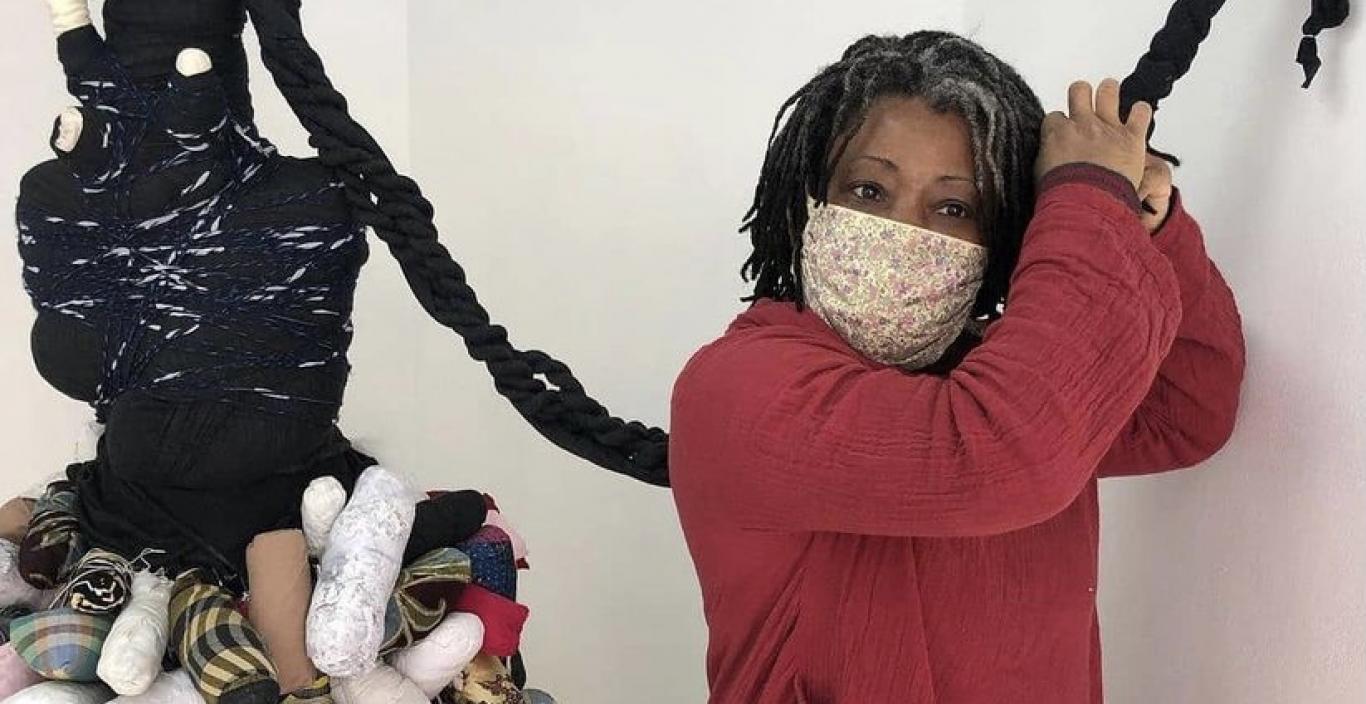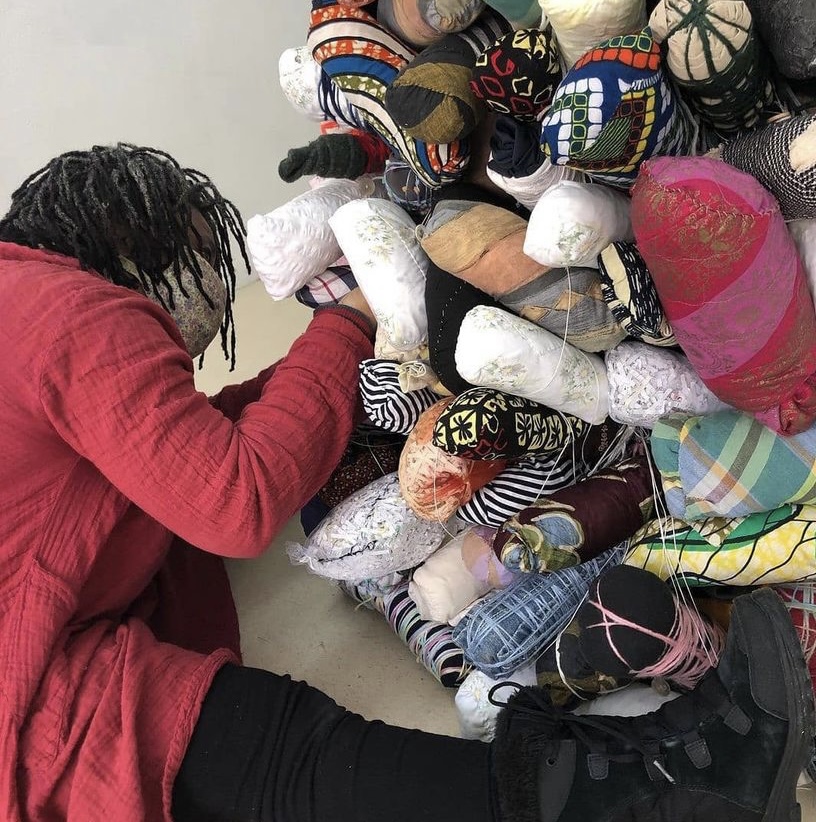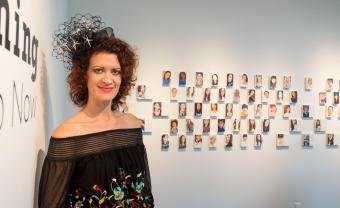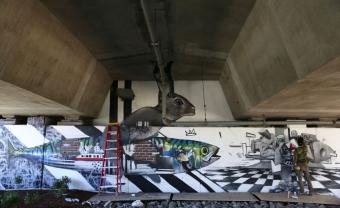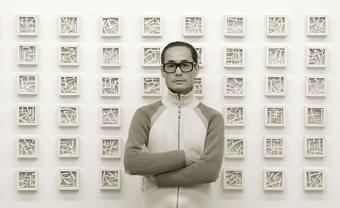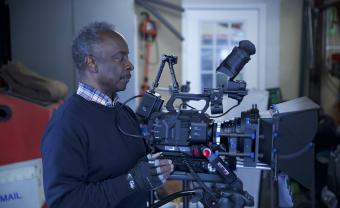Sika Foyer with one of her wrapped installation works. Photo by Hannah Barrett.
Sika Foyer’s clustered, cloth-wrapped sculptures call to mind piles of old-fashioned packages, bunches of grapes, bundled gifts. Her paintings, composed in layered, cracking acrylics mixed with ground coffee, are three dimensional, sculptural. Even her pen and ink drawings are composed of hundreds of tiny cells whose collective forms and texture almost emerge from the page, like an elaborate knitted pattern you can’t quite make out.
Her artistic focus is wrapping—a concept that for her encompasses metaphors of surface, and interior life, things concealed and revealed, divided and united. You can wrap anything, she observes—a gift, a story, even a culture.
“You can wrap it and sometimes when you unwrap it, you discover secrets and treasures or other things. I’m playing with it in different ways.”
A winding path
Sika took an unusual path to becoming an artist. Born in Togo, she came to the U.S. after high school to go to college and earned her B. A. in Economics from Baruch College, then a master’s degree in urban policy from The New School. Strong skills in math and finance landed her a successful career in real estate banking and economic development. But even then, she felt driven to create.
She was intrigued by people’s ability to reshape the image of what they were seeing, the unreliability of the human eye. She describes the imaginative way that children see, envisioning a monster from a pile of clothes in their darkened room.
“In Africa, I visited my grandparents in the villages where they lived and you’d walk maybe five miles to go to the farms. We’d see something in front of us on the path and be so afraid, but when we’d get close, it’s just a stick or a branch. But we were so sure that thing was moving.”
She started with photography but shied away from representational work.
“It was more like abstract photography,” she says.
She began drawing and painting in her free time and found a deep sense of joy and freedom in making art.
“When I'm working in my studio, I get lost in it,” she says. “I feel like I’m having a conversation with the work I’m doing. It just feeds me. And it makes me escape into a world where I’m at peace with myself.”
Finding a community of artists
She started programs at several art schools but never stayed long.
“I was always frustrated because I don’t necessarily see things the way other people see them,” she says. “I see things differently.”
She came to Boston in 2017 to care for her son who was struggling with mental health issues while studying at Massachusetts Institute of Technology (MIT). She moved to Cambridge while he was in treatment so she could be nearby if he needed her.
Walking through Porter Square, she passed by Lesley’s Lunder Arts Center and was struck by the artwork in the galleries. Intrigued, she put together a portfolio, applied to Lesley’s low-residency MFA in Visual Arts program and was accepted. This time, she didn’t leave.
“The work saved me,” she says. “I really devoted myself to it.”
The program provided both the artistic freedom she had been seeking, but also a creative community of faculty, mentors, and fellow students that she could look to for support and guidance as her work evolved.
“Having a whole community supporting me—it was completely different. It wasn't like ‘oh, you have to follow this rule.’ It was more like ‘okay, explain to me where you’re going.’”
She began to take bigger risks, working coffee beans and grounds into her paint to create uneven raised textures and cracks. Even in their jagged patterns, she realized that the cracks were forming a cohesive pattern.
“I embrace the cracking, because I felt like I use it as therapy for my work, my life,” she explains. “Sometimes you plan things out and they don’t go the way you want them to go. I realized that all the cracks were making a unit.”
Processing and unpacking grief through art
She devoted herself to caring for her son and making art. Slowly, her textured paintings led her to a new direction towards sculptural forms and shapes composed out of hundreds of elaborately constructed fabric bundles. She used wrapping in gallery installations and live performance pieces, creating living sculptures, swathed in fabric.
“I had so many griefs to process and I use art to process them. I wasn’t afraid to let go completely and take a risk and just let go and see where the art is taking me instead of trying to plan it out.”
For her, the metaphors of wrapping and unwrapping reflect more than just her personal struggles. She considers the transformative power of communities, the way individuals can become part of something larger, and also the separations and disconnection, the hidden pain beneath the surface.
“The way we were brought up, the way the African-American story started with colonization. It’s like a big wrapping that we cannot get out of. Those biases that we carry with us, over and over again—how do you unravel it?”
Since graduation Sika has done a solo show and two group shows, including the 2021 MFA thesis exhibit at MassMOCA in North Adams, Mass. Her son has graduated from MIT and is doing well. She’s interested in teaching, research, and in pursuing public art projects.
Her newest project involving books and materials passed down to her son from his father’s family of German Jewish intellectuals including Otto Zoff and Bertolt Brecht, many of whom experienced the traumas associated with the Nazi regime and the Holocaust. Extracting and assembling a family history from a storage unit stacked high with boxes of artifacts intrigues her. She contrasts this with the oral history traditions of her own family in Togo and how in each case, the truth can become hidden, distorted, or lost.
“You know that there’s something in there, but you have to find it,” she says. “Right now I’m thinking about piling up all the books … and organizing them to make a table and a chair.”
Learn more about our MFA in Visual Arts
Our flexible, low-residency MFA in Visual Arts program is one of the oldest and most recognized programs of its kind in the country. We are a vibrant community of diverse artists who work with students where they live in a program that’s 80% independent studio work, with residencies on our Cambridge campus twice a year.
Related Articles & Stories
Read more about our faculty, students and alumni.
